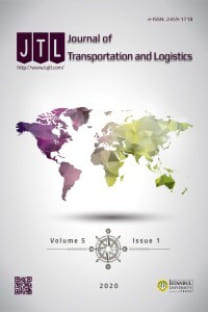Pricing of Contractual Shipments and Slot Allocation in Container Liner Shipping under Stochastic Environment
Pricing of Contractual Shipments and Slot Allocation in Container Liner Shipping under Stochastic Environment
Container shipping, contractual pricing, slot allocation, revenue management capacity management,
___
- Birge, J. R. (1982). The value of the stochastic solution in stochastic linear programs with fixed recourse. Mathematical Programming, 24(1), 314-325. https://doi.org/10.1007/BF01585113 google scholar
- Birge, J. R., & Louveaux, F. (2011). Introduction to Stochastic Programming. In Springer Series in Operations Research and Financial Engineering. Springer Science & Business Media. https://doi.org/10.1057/palgrave.jors.2600031 google scholar
- Chang, C. H., Lan, L. W., & Lee, M. (2015). An integrated container management model for optimizing slot allocation plan and empty container repositioning. Maritime Economics and Logistics, 17(3), 315-340. https://doi.org/10.1057/mel.2014.23 google scholar
- Costa, A., Ng, T. S. S., & Foo, L. X. X. (2017). Complete mixed integer linear programming formulations for modularity density based clustering. google scholar
- Discrete Optimization, 25, 141-158. https://doi.org/10.1016/j.disopt.2017.03.002 google scholar
- Feng, C. M., & Chang, C. H. (2008). Optimal slot allocation in intra-Asia service for liner shipping companies. Maritime Economics and Logistics, 10(3), 295-309. https://doi.org/10.1057/mel.2008.6 google scholar
- Feng, C. M., & Chang, C. H. (2010). Optimal slot allocation with empty container reposition problem for Asia ocean carriers. International Journal ofShipping and Transport Logistics, 2(1), 22-43. https://doi.org/10.1504/IJSTL.2010.029895 google scholar
- Fu, Y., Song, L., Lai, K. K., & Liang, L. (2016). Slot allocation with minimum quantity commitment in container liner revenue management: A robust optimization approach. International Journal of Logistics Management, 27(3), 650-667. https://doi.org/10.1108/JLM-06-2013-0075 google scholar
- Lu, H. A., & Mu, W. H. (2016). A slot reallocation model for containership schedule adjustment. Maritime Policy and Management, 43(1), 136-157. https://doi.org/10.1080/03088839.2015.1037371 google scholar
- Maggioni, F., & Wallace, S. W. (2012). Analyzing the quality of the expected value solution in stochastic programming. Annals of Operations Research, 200(1), 37-54. https://doi.org/10.1007/s10479-010-0807-x google scholar
- McCormick, G. P. (1976). Computability of global solutions to factorable nonconvex programs: Part I - Convex underestimating problems. Mathematical Programming, 10(1), 147-175. google scholar
- Ting, S. C., & Tzeng, G. H. (2004). An optimal containership slot allocation for liner shipping revenue management. Maritime Policy and Management, 31(3), 199-211. https://doi.org/10.1080/0308883032000209553 google scholar
- Ting, S. C., & Tzeng, G. H. (2016). Bi-criteria approach to containership slot allocation in liner shipping. Maritime Economics and Logistics, 18(2), 141-157. https://doi.org/10.1057/mel.2015.12 google scholar
- Wang, T., Tian, X., & Wang, Y. (2020). Container slot allocation and dynamic pricing of time-sensitive cargoes considering port congestion and uncertain demand. Transportation Research Part E: Logistics and Transportation Review, 144(November), 102149. https://doi.org/10.1016/j.tre.2020.102149 google scholar
- Wang, T., Xing, Z., Hu, H., & Qu, X. (2019). Overbooking and delivery-delay-allowed strategies for container slot allocation. Transportation Research Part E: Logistics and Transportation Review, 122(January), 433-447. https://doi.org/10.1016/j.tre.2018.12.019 google scholar
- Wang, Y., & Meng, Q. (2021). Optimizing freight rate of spot market containers with uncertainties in shipping demand and available ship capacity. Transportation Research Part B: Methodological, 146, 314-332. https://doi.org/10.1016/j.trb.2021.02.008 google scholar
- Wang, Y., Meng, Q., & Du, Y. (2015). Liner container seasonal shipping revenue management. Transportation Research Part B: Methodological, 82, 141-161. https://doi.org/10.1016/j.trb.2015.10.003 google scholar
- Wong, E. Y. C., Tai, A., & Raman, M. (2015). A maritime container repositioning yield-based optimization model with uncertain upsurge demand. Transportation Research Part E: Logistics and Transportation Review, 82, 147-161. https://doi.org/10.1016/j.tre.2015.07.007 google scholar
- Zurheide, S., & Fischer, K. (2012). A revenue management slot allocation model for liner shipping networks. Maritime Economics and Logistics, 14(3), 334-361. https://doi.org/10.1057/mel.2012.11 google scholar
- Zurheide, S., & Fischer, K. (2015). Revenue management methods for the liner shipping industry. Flexible Services and Manufacturing Journal, 27(2-3), 200-223. https://doi.org/10.1007/s10696-014-9192-0 google scholar
- Yayın Aralığı: 2
- Başlangıç: 2015
- Yayıncı: İstanbul Üniversitesi
Evaluating Trigger Effects of Covid-19 on Supply Chain Integration
Gülden ORAL, Mahmut MOLLAOĞLU, Umur BUCAK
İç Entegrasyonun Lojistik Hız Ve Güvenirlik Üzerindeki Etkisi: Müşteri Entegrasyonun Aracı Rolü
Akıllı Şehir Lojistiği Kapsamında Akıllı Ulaşım Sistemleri (AUS) için Sistem Analizi
